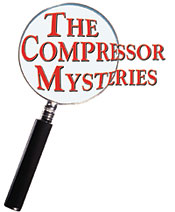
John is a refrigeration contractor. He works long hours and has to deal with all manner of systems and customer personalities on accounts ranging from small convenience stores to large commercial customers.
One of his customers is a local Bag-Yer-Own store. It had been part of a major chain but then the company tightened its fiscal belt; the chain stores got fancier and the stores in more urban areas became Bag-Yer-Owns - barebones, self-serve, discount price supermarkets. The manager's main goal is to keep overhead down as much as possible.
One thing John can count on for both the higher-end and the reduced-cost stores is that they don't want to spend more money on their refrigeration systems than is absolutely necessary. Employee wages at the chain stores were slightly higher, but there were more of them per square foot of store.
The manager of that local Bag-Yer-Own called John out in the early, early morning because his low-temp refrigeration units lost case temperature, and the manager was losing product.
A few months ago they were tripping sporadically on the oil safety. At the time, John reset the safety and told the manager to call him when the problem happened again; the reason for the trips needed to be investigated.
The manager, however, saw how John reset the safety and decided he could do that himself. Besides, he told himself, he couldn't afford the service calls.
This is an older, unsophisticated refrigeration system; nothing is twinned together, there are no fancy remotes. The oil trips have been occurring on a couple of R-22, low-temp, electric defrost systems in the frozen food section.
When John gets there in the wee hours of the morning, before the store opens to the public, a reach-in holding not-so-frozen pizzas is down. So is the case with ice cream.

Pushing Buttons
The manager tells John that he has been resetting the oil safety for a couple of months, the way John did the first time the problem occurred. Last night the manager thinks he didn't catch it in time. He has been pushing the reset about three times a week.John walks back to the equipment room, where he finds a high oil level in the compressor sight glass - it's actually above the top of the glass. After installing his gauges, John pushes the reset button and the compressor starts. It rattles for a bit, and then settles down.
After a few minutes, John looks at the gauge he attached to the oil pump; it reads 42 psig. John thinks to himself, "With an oil pressure like that, the control should not have tripped"; however, the cases are warm and the pressures are high. So, John decides to let the system run awhile, allowing some time for the case temperature to come down and the system to balance out.
Now the case temperature has pulled down to near its normal operating temperature. John looks at the oil pressure again and finds the gauge at 38 psig. Now it's lower, but John figures that is because the system has pulled down to operating pressures. It is still above the 9-psid trip point of the control.
Why is this control tripping multiple times a week?
Let's hear from you: What is your best answer to this troubleshooting question? Visit the Contractor Connection at www.emersonclimatecontractor.com to submit your answers. Emerson Climate
Technologies will award prizes to the winner and participants. The winner's answer will be published in an upcoming issue of The News. All entries must be received no later than Sept. 27.
Sidebar: System Parameters
Compressor model: 3DA3-075E-TFCSerial number: 99C-19765
Case temperature: 5 degrees
Suction pressure: 20 psig
Discharge pressure: 228 psig
Ambient: 81 degrees
Oil pump pressure: 38 psig
Pressure at the evaporator: 22 psig
Temperature at the TXV bulb: 4 degrees
Suction line temperature at the compressor: 20 degrees
Discharge line temperature at the compressor: 215 degrees
Voltage at the compressor terminals: 218
Amperage at the compressor: 36 (21.5 on the curve)
Winding resistance: 0.3 ohms
RLA: 41
Bell is with Emerson Climate Technologies. Barbara Checket-Hanks is Service/Maintenance and Troubleshooting Editor for The News. She can be reached at barbarachecket-hanks@achrnews.com.
Publication date: 09/13/2004

Report Abusive Comment